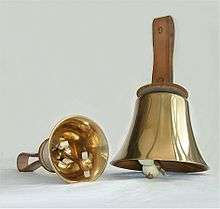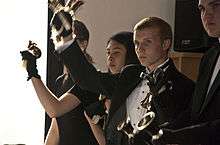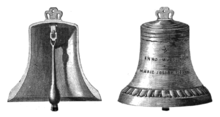Handbell
A handbell is a bell designed to be rung by hand. To ring a handbell, a ringer grasps the bell by its slightly flexible handle – traditionally made of leather, but often now made of plastic – and moves the arm to make the hinged clapper inside the bell strike. An individual handbell can be used simply as a signal to catch people's attention or summon them together, but handbells are also often heard in tuned sets.
 | |
| Percussion instrument | |
|---|---|
| Classification | Percussion |
| Hornbostel–Sachs classification | 111.242.222 (Sets of clapper bells) |
| Inventor(s) | Robert and William Cor |
| Developed | 1696–1724 |
| Related instruments | |
History
The first tuned handbells were developed by ancient Vedic civilizations situated in the Indian Subcontinent, such as the Harrapan and Mohenjodaro civilizations. In Western European civilization credit for the development of the hand bell, or "handbell", is accorded to brothers Robert and William Cor in Aldbourne, Wiltshire, England, between 1696 and 1724.[1] The Cor brothers originally made latten bells for hame boxes,[2] but for reasons unknown they began tuning their bells more finely to have an accurate fundamental tone and fitted them with hinged clappers that moved only in one plane.[1] A foundry in Loughborough, Leicestershire, that originated in the 14th century became John Taylor & Co in 1784.
Originally, tuned sets of handbells, such as the ones made by the Cor brothers, were used by change ringers to rehearse outside their towers. Tower bell ringers' enthusiasm for practicing the complicated algorithms of change ringing could lead to can easily exceed the neighbours' patience, so in the days before modern sound control handbells offered them a way to continue ringing without causing annoyance. It was also more pleasant for the ringers to learn and practise in the warmth of the local pub rather than in a cold tower in winter.[3] The handbell sets used by change ringers had the same number of bells as in the towers – generally six or twelve tuned to a diatonic scale.[3]
Handbells were first taken to the United States from England by Margaret Shurcliff in 1902. She was presented with a set of 10 handbells in London by Arthur Hughes, the general manager of the Whitechapel Bell Foundry after completing two separate two-and-a-half-hour change ringing peals in one day.[4]
Terminology

The bells used in American handbell choirs are almost always English handbells. "English handbells" is a reference to a specific type of handbells, not to the country of origin. While some American handbell choirs do use bells made in England, the majority play bells made either by Malmark Bellcraftsmen or by Schulmerich Bells, both based in Pennsylvania.[5]
In the United Kingdom, there is a distinction between "American handbells" and "English handbells"; English handbells are traditional, with leather clapper heads and handles (such as the bells Whitechapel makes), while American handbells use modern materials, such as plastic and rubber, to produce the same effect (such as those produced by Malmark and Schulmerich). In America, however, they are all called English handbells.
Characteristics
The two major defining characteristics of English handbells are their clappers and ability to produce overtones. The clapper on an English handbell is on a hinge and moves back and forth in a single direction, unlike a school bell in which the clapper swings freely in any direction. It also has a spring that holds the clapper away from the casting after the strike to allow the bell to ring freely. Furthermore, the shaft of the clapper is rigid, such that the bell may be held with its mouth facing upward. The overtones on an English handbell are a 12th (an octave and a perfect fifth) above the fundamental, while Dutch handbells – such as Petit & Fritsen – focus on the overtone a minor 10th (an octave and a minor third) or a major 10th (an octave and a major third) above the fundamental.
Handbells can weigh as little as 7 oz (200 g) or upwards of 18 lb (8.2 kg).[6]
Performance

A handbell choir or ensemble (in the United States) or handbell team (in England) is a group that rings recognizable music with melodies and harmony, as opposed to the mathematical permutations used in change ringing. The bells generally include all notes of the chromatic scale within the range of the set. While a smaller group uses only 25 bells (two octaves, G4–G6), the sets are often larger, ranging up to an eight-octave set (97 bells, C1–C9). The bells are typically arranged chromatically on foam-covered tables; these tables protect the bronze surface of the bell, as well as keep the bells from rolling when placed on their sides. Unlike an orchestra or choir in which each musician is responsible for one line of the texture, a handbell ensemble acts as one instrument, with each musician responsible for particular notes, sounding his or her assigned bells whenever those notes appear in the music.
Music
Handbell choirs generally ring music composed or arranged specifically for handbells because of their highly resonant sound, the limited note range of a set, and the unique pitch-by-pitch division of the staff among the ringers.
There are several major publishers providing printed handbell music such as the Hope Publishing Company, The Lorenz Corporation and Alfred Music as well as free sites from individual composers and arrangers. Costs associated with handbell music typically result from shipping (many scores are only published in hard-copy) and dissemination; as most scores do not permit duplication and must be purchased individually for each ringer.
The coordination of the ringers requires a different approach than other ensembles. All the ringers read from a score. This score is similar to a piano score, but with an additional convention: The C♯ above middle C and all notes below are always written in the bass clef, and the D♭ above middle C and all notes above are always written in the treble clef. (This formatting is not always the convention for solo and small-ensemble music.) Handbell music is written one octave lower than the sound the bells make, so a middle C bell is playing the note C5.[7][8] (For simplicity, the bell would still always be referred to as middle C or C5.)
Due to handbells' relative rarity outside of the confines of church services—although less so now than in the 1980s and early 1990s—the majority of pieces last approximately four minutes. A few composers and arrangers write longer and more intricate works; generally these pieces use handbells in combination with other instruments.
.jpg)
Ringing techniques
To ring a handbell, the ringer moves it in such a way that the clapper strikes the inside surface of the bell, usually holding it against his or her shoulder, bell upwards, and then swinging the bell through an elliptical shape to cause the clapper to strike the casting. The tone of the bell will continue to resonate, decaying naturally until it stops completely or the ringer stops it by damping the bell with a hand or on the body or a padded surface.[9]
Handbell techniques have changed very much over the years. Donald Allured, founding director of Westminster Concert Bell Choir, is credited with fully realizing an American off-the-table style of ringing that includes many non-ringing sound effects including stopped techniques such as plucking the clapper with the bell on the table. He is also credited for promoting precise damping or stopping of the sound by touching the bell to a soft surface, in the service of more musical results.
Multiple-bell techniques
Normal ringing technique only allows a ringer to ring two bells at a time, one in each hand. Depending on the number of bells needed for a particular piece and the number of ringers, it may be necessary for each ringer to ring more than two bells at a time or in short succession (four-in-hand) There are also many techniques that change the sound of the bell as it is rung.
Four bells

There are two main ways of ringing two handbells with one hand: four-in-hand and Shelley.
In the four-in-hand technique, the ringer hold two bells in one hand with the clappers at right angles to each other. This allows the ringer to either move the hand normally ("ring" – primary bell) or ring knuckles-first ("knock" – secondary bell) to ring two bells independently with the same hand (for a total of four bells when ringing with both hands). The two bells can also be played simultaneously by holding the wrist at a 45° angle. In large ensembles, four-in-hand is typically used to ring multiple positions or pick up accidentals.
Shelley ringing is similar, except that the clappers are each orientated in the same direction, so that the two bells normally ring simultaneously with one movement. Shelley is typically used to ring notes in octaves, but can also be used to ring two notes separately by striking the primary bell sideways and the secondary bell forward in an action like tapping the fingers.[10]
As to the relative merits of the two techniques, some believe that Shelley ringing is rendered obsolete when four-in-hand is perfected, while others believe that the motion of the clappers in the same plane makes certain techniques more feasible, particularly shaking, martellato and vibrato.
Six bells
There are several ways to play six bells at a time (i.e., to ring three bells in each hand). One way is to pick two bells up as if one were Shelley ringing, then pick the third up between one's little and ring fingers (a 'triple Shelley'). All three bells ring together when ringing in a knocking motion. A second way is to pick up the third bell sideways so the clapper swings outward. Ringers with good control can then ring the first bell without ringing the third, allowing him or her to play three notes in one hand.[11]
Weaving
Weaving is the technique of playing a succession of bells by changing which bell is in each hand as required. This is used by bass and solo or small-ensemble ringers. The large size and weight of bass bells makes four-in-hand ringing impractical and impossible, and often a solo or small-ensemble ringer will need to move up and down a range of bells, possibly sharing them with others. This technique means more than two bells can be rung in short succession, using the table to damp and free the hand to pick up the next bell. If the ringing sequence requires bells to be rung in tonal order, this technique often results in a weaving pattern as the ringer must often reach across his or her body for the next bell.[12] Weaving can also be used in combination with the four-in-hand in a technique called "traveling four-in-hand". By combining the ability to hold two bells in each hand with the ability to quickly drop and pick up the secondary bell of a four-in-hand, a ringer has quick access to several bells.
Other techniques

There are other ways to play music besides traditional ringing. Other techniques include plucking, shaking (or trilling), table damping (or martellato), and malleting bells (on the table or suspended).
Echo technique adds a brief pulse of increased volume to a sustained note. This is accomplished by gently touching the rim of a vibrating bell to the table.[8]
Gyro is a technique that involves holding the bell in a vertical position, then rotating it clockwise or counterclockwise slowly to create a small vibrating sound; this can also be done horizontally to push the sound outwards.[13]
Malleting involves using one of several types of rubber, plastic, or yarn-wrapped mallet to strike the casting of the bell. This can create a staccato tone when the casting is pressed into padding, a normal tone when the bell is suspended, or even a drum-roll effect when multiple mallets are used or multiple hits on the bell are played. Suspended malleting can be employed to create a bell tree which allows many bells to be played by one ringer.[14]
Martellato also creates a staccato tone and is accomplished by striking the bell into the foam in such a way that the clapper strikes the casting immediately after the bell strikes the foam. A variation called a "Mart Lift" is accomplished by lifting the bell off the table very soon after the clapper strikes. This creates a staccato tone followed by a softened sounding of the bell.[8]
Plucking is accomplished by using the thumb and forefinger to force the clapper head into the casting while the bell is on the table with the handle toward the ringer, producing a staccato tone.[15]
Shaking is accomplished by rapidly ringing the bell back and forth so the clapper strikes the front and back of the casting in quick succession. This creates a continuous sound, as opposed to normal ringing in which the tone decays rapidly after sounding. Because of their size, bass bells are rarely shaken.[16] A suspended mallet roll is usually played if a shaking sound is desired on a bass bell.
The singing bell technique creates a sustained pitch similar to the sound a wineglass makes as its rim is rubbed with a wet fingertip and is accomplished in much the same way. A short wooden dowel is touched to the outside of the rim of a handbell which is being held in the other hand. The dowel is then used to rub the rim in a circular motion. The Singing Bell technique is adapted from the "Singing Bowl" tradition of Tibet.[8]
A tower swing is when the bell is rung and then swung down and a bit behind the ringer and back up to the normal position. This creates an "echo" effect. The mouth of the bell must rotate around to create the sound change that resembles a tower bell. Usually this is done over a period of three or four beats.
Thumb damp provides a staccato sound similar to plucking or malleting on the table. This is often described as a "tinkling" sound. The bell is rung with a thumb and/or several fingers touching the outside below the rim; this damps the sound immediately after the bell is rung. This technique can often be easier than plucking or malleting with smaller bells.
Notation
There are a number of abbreviations and notations used exclusively or almost exclusively in handbell music:
- LV ("laissez vibrer" or "let vibrate", similar to a piano's sustain pedal)
- R ("ring", regular ringing or meaning to end the LV)
- SK ("shake", i.e. shaking the bell continuously during the duration of the note)
- TD ("thumb damp", ringing the bell with a thumb on the casting to create a staccato note)
- PL ("pluck", which means to throw down the clapper while the bell lies on the table)
- ▲ ("martellato", to strike bell against padding of the table, pushing the casting firmly against padding as to quickly dampen sound)
- SW ("swing", to play the bell in a normal position, swing it down to the waist, then bring it back up)
- BD ("brush damp", brushing the rim of the bell against the ringer's chest to cause a quick diminuendo) and
- ↑ or ↪ ("echo", ringing the bell and then touching it very briefly to the table, creating an echo effect).[13][17]
Handbell tree
Handbells can be played as a handbell tree where the handles are interlaced within each other, allowing multiple bells to be played with mallets to obtain an undamped sound. This performance technique was invented by Louise Frier in the 1980s. It was further developed by Barbara Brocker who developed a standardized bell layout. It is used by many soloists. The notational symbol used for Handbell Tree features a series of interlocking diagonal lines, one for each handbell. The pitch is placed at the lowest point of each diagonal line.[8][18][19][20]
See also
Other
Composers and arrangers
Performers
- Bells on Temple Square
- Dorothy Shaw Bell Choir
- Embellish Handbells (of West Michigan)
- Forté Handbell Quartet
- Pikes Peak Ringers
- The Raleigh Ringers
- Milwaukee Handbell Ensemble
References
- Markey, Willard H. (May–June 1997), "More History?: From Hame Boxes to Handbells", Overtones, 43 (3): 36–37
- A hame box is a device that attaches to the top of a horse collar and contains several bells that ring when the horse moves. For more information about the Cor brothers and a picture of a hame box, see A Brief History of The Aldbourne Bell Foundries.
- Theile, Ron. "The History of Handbell Ringing". Retrieved 2009-08-13.
- Bullen, Nigel (March–April 1998), "Researching the History of Handbells: In the Beginning", Overtones, 44 (2): 37–38
- "The Great Handbell War". NPR.org. Retrieved 2017-12-25.
- "Handbell Weights and Measurements". www.olypen.com. Retrieved 2017-12-25.
- Schmidt-Jones, Catherine. "Transposing Instruments". Retrieved 2008-03-08.
- The American Guild of English Handbell Ringers, Handbell and Handchime Notation. AGEHR 2010
- Moore, Daniel K. (May–June 1998), "Technique-ly Speaking: The Basic Ringing Stroke/Shoulder Damp", Overtones, 44 (3): 10–11
- Leonard, Karen E. (September–October 2000), "Technique-ly Speaking: Shelley Ringing", Overtones, 46 (5): 13–14
- Anderson, Christine (2000-01-14). "Multiple Bells In-Hand". Retrieved 2009-08-13.
- Allured, Don (May–June 1999), "Technique-ly Speaking: The Weave and Other Multiple Bell Doings", Overtones, 45 (3): 41–44
- "Handbell Notation Symbols & Definitions". Handbell World. Retrieved 24 October 2015..
- Frier, Louise (September–October 1999), "Technique-ly Speaking: Malleting Suspended Handbells", Overtones, 45 (5): 14–16
- http://www.ling.upenn.edu/~kingsbur/articulations.html Archived 2009-08-10 at the Wayback Machine. Retrieved 2009-10-09.
- Ebling-Thorne, Kathy (September–October 1998), "Technique-ly Speaking: The Shake and The Trill – What a Thrill!", Overtones, 44 (5): 9–10
- http://www.ling.upenn.edu/~kingsbur/articulations.html Archived 2009-08-10 at the Wayback Machine, accessed 10/09/09
- Tipton, Nancy (6 September 2011). "proper term". emp-handbell-l (Mailing list). Retrieved 7 September 2011.
- "The Founder". Belltrees and More, Inc. 2009–2010. Archived from the original on 9 September 2011. Retrieved 7 September 2011.
- "Barbara Brocker Bio". choraegus. 31 January 2011. Archived from the original on May 5, 2014. Retrieved 3 May 2014.
External links
| Wikimedia Commons has media related to Handbells. |
- Handbell Ringers of Great Britain
- Handbell Musicians of America
- Handbell at Curlie
- Schulmerich Bells
- Malmark Bells
